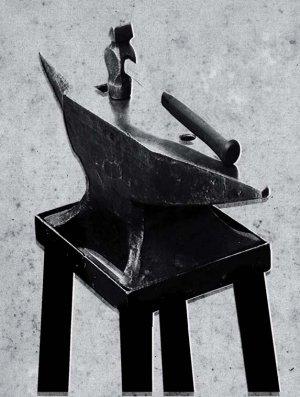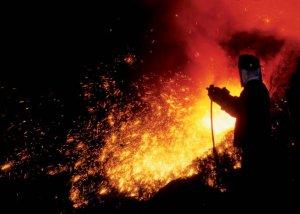Mining War: Steelmakers Unite
By Michael Condon
As the pit fight over raw commodities intensifies, the nation’s five biggest steelmakers and trading giant Itochu have banded together to take on the mining companies.

Chapter 1: The deal
In November each year, representatives of the world’s most powerful mining and steelmaking companies sit around tables and decide what the standard price for iron ore will be for the year. It’s a decades-old practice, reminiscent of union-management brawls that companies from both sides are used to. The bitter and lengthy talks continue until the first steelmaker accepts a price—then the others follow.
But this year was different.
In February, Japanese and South Korean steelmakers, with JFE Steel and Nippon Steel leading the way, agreed to pay Brazilian mining giant Vale (formerly Companhia Vale do Rio Doce) 65 percent more on iron ore during fiscal 2008. Nippon Steel, the world’s second biggest steelmaker, said that it would pay $78.90 per metric ton for Vale’s Itabira fine ore, up from the $47.81 it paid the previous fiscal year. JFE, the world’s No. 3 steelmaker, agreed to pay 118.98 cents per dry metric ton FE unit, up from 72.11 cents. In negotiations with other Asian customers, Vale pushed up its prices by as much as 71 percent.
Skyrocketing demand for raw materials led to Vale, which supplies 40 percent of the world’s iron ore, taking a bully-boy position— and it didn’t stop there. In early September, according to industry officials, Vale sent an email to its Chinese and Japanese customers saying that it would increase the price by an extra 20 percentage points. It was an unprecedented step, the ramifi- cations of which are being felt across the multi-billion-dollar global steel industry.
In June and July, BHP Billiton and Rio Tinto, the world’s two biggest mining companies, followed suit. They increased their prices of iron ore, the chief material needed to make steel, by up to 97 percent. The reality was that in June, Rio Tinto’s deal with China’s largest steelmaker, Baosteel, effectively destroyed the unified pricing system. Up until that point there had been one global price—an onboard quote before shipping, which every company in the industry paid no matter where they were located. Vale’s move changed everything—and that was before BHP Billiton launched it’s hostile bid to buy Rio Tinto Group.
Chapter 2: The takeover
Flash back to 2001—Australia’s Broken Hill Proprietary Company (BHP) and London-based Billiton merge to form the world’s second biggest mining company. Six years later, on the back of four consecutive years of record profits, BHP Billiton had moved into the number one position. In terms of iron ore shipments, the company is now second only to Vale, controlling 25 percent worldwide.
In March this year, the mining giant launched a $118.7 billion bid to buy Rio Tinto Group, a move that would see it take control of almost 40 percent of the world’s iron ore supplies. The Japanese business community vehemently opposed the move while the Japan Fair Trade Commission launched a probe into the proposal. "Monopolization of iron ore and other commodities...would create a ‘grave problem for the global economy’."
Fujio Mitarai, President Nippon KeidanrenNippon Keidanren, Japan’s largest and most powerful business lobby group, launched an offensive against the bid with President Fujio Mitarai telling reporters in Tokyo that the acquisition could lead to the monopolization of iron ore and other commodities and would create a “grave problem for the global economy.”
The developments so far this year have caused Japanese steelmakers to drastically rethink their position. Historically, the big steelmakers have kept out of mining, instead shipping in the raw materials from abroad. A decade ago there was a gap in the market, and excess capacity meant that it worked in the mining companies favor to set a standard annual price. But with the gap now closed—the result of increased demand, particularly in China—the suppliers have initiated a bidding war. This, coupled with increases in shipping costs caused by rapidly increasing oil prices, has pushed the steelmakers into a corner.
Chapter 3: Taking matters into their own hands
In August, the Nikkei newspaper reported that Nippon Steel Corp., JFE Holdings, general trading giant Itochu Corp. and a number of other major Japanese steelmakers would form a consortium to acquire overseas mining rights for iron ore.
The Japanese government itself has also entered the fray, offering low-interest loans through the Japan Bank of International Cooperation.
The Nikkei’s report said the acquisitions would likely total around 1 trillion yen ($95.6 billion) which would make it the biggest resources-related investment by Japanese businesses ever.
Last month, new reports were made that the group, which includes Sumitomo Metal Industries, Kobe Steel and Nisshin Steel, were bidding for Brazilian steelmaker Cia Siderurgica Nacional’s (CSN) Namisa iron ore unit, estimated to be worth 10 billion yen. It was the first directed shot at the mining industries’ territory by the Japanese steelmakers.
Just prior to this in August, the world’s biggest steelmaker, ArcelorMittal, bought Brazilian iron ore assets for $810 million. In May of the previous year, Oslo-listed London Mining bought the same assets for $68 million and then invested $32 million in mine development. The fact that ArcelorMittal paid eight times the price is testament to just how desperate steelmakers are to shore up the raw materials needed for their manufacture. Presently, the steelmaker is 45 percent self-reliant in terms of iron ore. By 2012 it aims to be 75 percent self-reliant.
 Skyrocketing iron ore costs have led Japan’s steelmakers to take on the world’s biggest mining companies at their own game.
Skyrocketing iron ore costs have led Japan’s steelmakers to take on the world’s biggest mining companies at their own game.
China, another of the big losers at the hands of the mining companies, has declared that it wants to own one third of the world’s iron ore resources. The Asian power has acquired assets in the unstable, resourcerich regions of Africa and has grabbed other ore assets in Australia through both friendly and hostile acquisitions. This year, China’s crude steel production is expected to be 530 million tons. By 2015, it is expected to rise to about 780 million tons. For that reason, China is closely watching BHP Billiton’s hostile bid for Rio. Some within the industry even believe that China’s steel makers, backed by a sovereign wealth fund, may provide Rio Tinto with the money needed to stop the bid.
Chapter 4: To be continued…
Set to a backdrop of rapidly increasing commodities prices, the latest developments may create a yardstick for how manufacturers in other industries react to moves by suppliers to push up prices.
In August, Japan’s corporate goods price index (CGPI) remained above 7 percent in August for the second straight month. The index stood at 7.2 percent higher than a year earlier. This followed the 7.3 percent of the previous month, indicating that the country remained under the heel of the highest cost surge since the early 1980s. The CGPI increases were directly related to the inflation of the prices of raw commodities, for example, prices for petroleum and coal products were up 43.3 percent while steel prices increased 28.6 percent. Crude oil prices dropped about 30 percent from its record near-$150 barrel in mid-July, largely due to a decrease in demand in the US. But the decline has yet to be passed on.
The 0.1 percentage CGPI decrease has some analysts saying that the inflation has hit a high-water mark but the scramble for raw materials, particularly iron ore, is set to continue. For countries such as Japan, heavily reliant on imported raw materials for manufacturing, the changes in the steel industry represent a dangerous precedent. On September 17, Nippon Steel announced that it would increase its prices by 5,000 yen ($47.82) a metric ton to reach 110,000 yen and even a possible 120,000 yen. This followed increases in April and July that pushed the prices up by a total of 30,000 yen a ton.
Earlier in the year, a report from market research company Teikoku Databank (TDB) showed that there were 254 bankruptcies related to the high cost of raw materials from April 2007 to February 2008. TDB indicated that since October 2007, the bankruptcy numbers increased directly with the increase in the prices of international commodities such as crude oil. This compared to 142 for all of 2006. In February 2008, there were 33 raw material related bankruptcies, a record for the market research company’s data on the subject, which they began collecting in April 2005.
The oil shock earlier in the year was a major factor in pushing up costs for manufacturing worldwide. While it has dropped back down, the price will continue to rise in the future. Meanwhile, the scramble for raw materials will continue as demand increases and resources become increasingly scarce. The creation of a situation where two companies would control almost 80 percent of the world’s iron ore supply, and prices are arbitrarily raised by mining companies, would be dangerous for not only steelmakers, but also for manufacturers and consumers. The next year will see a tectonic shift as steelmakers scramble to get their hands on the raw materials while mining companies force their way into the steelmaking industry (Vale has already announced that it plans to build a $5 billion steel mill complex). When the dust settles, the rules of the mining game will have been rearranged—where Japan sits on the board remains to be seen.





